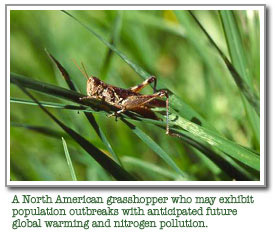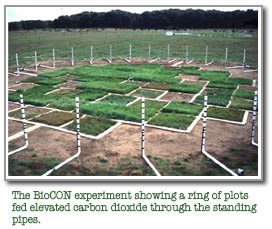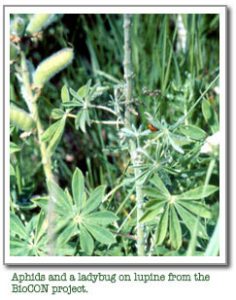Global change in carbon and nitrogen budgets and plant-herbivore interactions
 Over the next 40-50 years, the global concentration of carbon dioxide in the atmosphere is expected to increase by 75% and climate should warm by 2-4°C. In some areas of the world, nitrogen pollution in the atmosphere and groundwater is expected to double the available nitrogen for plant growth. On top of these changes, species are being lost a rate equivalent to catastrophic extinction events in the paleontological record. While these changes are well-documented individually, and their consequences for plant production and nutrient cycling determined in several experiments, their combined consequences on ecosystems are virtually unknown. A key component of ecosystem functioning is insect herbivory, through which primary production is transferred to the animal food web. However, virtually no studies have explored the effects of warming, carbon dioxide enrichment, nitrogen deposition, and/or loss of plant diversity on insect abundance and diversity and the impacts of insects on plants
Over the next 40-50 years, the global concentration of carbon dioxide in the atmosphere is expected to increase by 75% and climate should warm by 2-4°C. In some areas of the world, nitrogen pollution in the atmosphere and groundwater is expected to double the available nitrogen for plant growth. On top of these changes, species are being lost a rate equivalent to catastrophic extinction events in the paleontological record. While these changes are well-documented individually, and their consequences for plant production and nutrient cycling determined in several experiments, their combined consequences on ecosystems are virtually unknown. A key component of ecosystem functioning is insect herbivory, through which primary production is transferred to the animal food web. However, virtually no studies have explored the effects of warming, carbon dioxide enrichment, nitrogen deposition, and/or loss of plant diversity on insect abundance and diversity and the impacts of insects on plants
 In the past few years, I have conducted a series of experiments at the Cedar Creek Natural History Area in Minnesota to address some of these issues. A long-term experiment that explores the impact of bird predators on grasshoppers, a dominant insect herbivore, shows dramatically greater grasshopper abundance with added nitrogen, but only in years following warmer than normal summers. These results suggest that future warming and nitrogen pollution combined could elicit unexpected outbreaks of insects that would detrimentally affect agriculture.
In the past few years, I have conducted a series of experiments at the Cedar Creek Natural History Area in Minnesota to address some of these issues. A long-term experiment that explores the impact of bird predators on grasshoppers, a dominant insect herbivore, shows dramatically greater grasshopper abundance with added nitrogen, but only in years following warmer than normal summers. These results suggest that future warming and nitrogen pollution combined could elicit unexpected outbreaks of insects that would detrimentally affect agriculture.
 More recent work focuses on the combined effects of enhanced carbon dioxide and nitrogen and plant diversity loss on insects. This work centers on the large BioCON (Biodiversity, CO2, and N) project at Cedar Creek, a large factorial experiment of 342 grassland plots that receive ambient and elevated CO2 and N, and contain different numbers of plant species. Early results show that outbreaks of aphids on legumes are depressed by elevated CO2, as are the abundance and species richness of all leaf-feeding insects and predators. Nitrogen addition does not help compensate for these effects, and the effects of CO2 are amplified in plots with high plant species richness. These results suggest that grasslands with high plant species richness may be most sensitive to changes in atmospheric CO2 and may lose a substantial fraction of their insect diversity.
More recent work focuses on the combined effects of enhanced carbon dioxide and nitrogen and plant diversity loss on insects. This work centers on the large BioCON (Biodiversity, CO2, and N) project at Cedar Creek, a large factorial experiment of 342 grassland plots that receive ambient and elevated CO2 and N, and contain different numbers of plant species. Early results show that outbreaks of aphids on legumes are depressed by elevated CO2, as are the abundance and species richness of all leaf-feeding insects and predators. Nitrogen addition does not help compensate for these effects, and the effects of CO2 are amplified in plots with high plant species richness. These results suggest that grasslands with high plant species richness may be most sensitive to changes in atmospheric CO2 and may lose a substantial fraction of their insect diversity.
Future work needs to address the chemical changes in plants that explain these insect population and community responses to global change factors. In addition the response of different insect groups, such as those that feed on plant sap, parasitoids, and predators, need to be better understood. Finally, there is considerable potential to explore the effects of warming and nitrogen deposition on mutualistic interactions, such as those between ants and aphids feeding on the leaves of oak trees
Selected Related Publications:
Haddad, N., D. Tilman, J. Haarstad, M.E. Ritchie, and J.M.H. Knops. 2001. Contrasting effects of plant diversity and composition on insect communities: a field experiment. American Naturalist 158: 17-35.
Engelhardt, K.A. and M.E. Ritchie. 2001. Effects of plant diversity on wetland ecosystem function and services. Nature 410: 687-689. [Click here for PDF]
Ritchie, M.E. 2000. Nitrogen limitation and trophic vs. abiotic influences on insect herbivores in a temperate grassland. Ecology 81: 1601-1612. [Click here for PDF]
Knops, J.M.H., D.Tilman, N. Haddad, J. Haarstad, S. Naeem, C. Mitchell, M.E. Ritchie, K. Howe, J. Groth, P. Reich. 1999. Cascading effects of plant diversity on invasions, diseases, and insects. Ecology Letters2: 286-293.
Siemann, E., Tilman, D., Haarstad, J. and Ritchie, M.E. 1998. Experimental tests of the dependence of arthropod diversity on plant diversity. American Naturalist 152: 738-750.
Tilman, D., Knops, J.M.H., Wedin D., Reich P., Ritchie, M.E., and Siemann, E. 1997. Functional diversity and composition influence ecosystem processes. Science 277: 1300-16.
Tilman, D., S. Naeem, J.M.H. Knops, P. Reich, E. Siemann, D. Wedin, M.E. Ritchie, and J.H. Lawton. 1997. Biodiversity and ecosystem properties. Science 277: 1866-1867.
Ritchie, M.E. 1996. Interaction of temperature and resources in population dynamics: an experimental test of theory. Pages 79-92 In: Floyd, R.B., Sheppard, A.W., and DeBarro, P.J. (eds.) Frontiers in Population Ecology. CSIRO Press, Melbourne.
